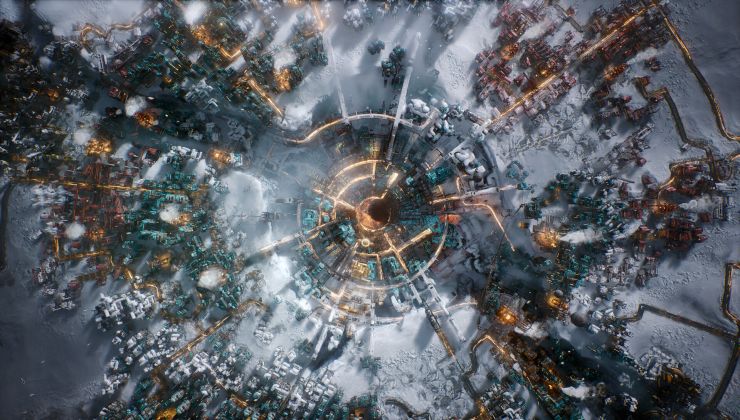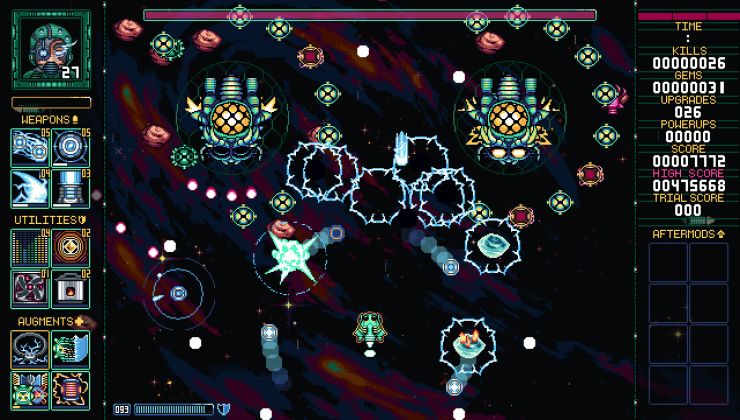With a rather unassuming and plain case that doesn't give much away, the new TUXEDO Book XP14 is their smallest and lightest gaming notebook now available.
 Coming with Intel Tiger Lake processors with either the Core i5-1135G7 or the Core i7-1165G7 it's backed up by their new Xe graphics, you can also upgrade it to have an NVIDIA GeForce GTX 1650 if you want that extra bit of power for your gaming needs.
Coming with Intel Tiger Lake processors with either the Core i5-1135G7 or the Core i7-1165G7 it's backed up by their new Xe graphics, you can also upgrade it to have an NVIDIA GeForce GTX 1650 if you want that extra bit of power for your gaming needs.
Not only does it have ample power, it also has a speedy 14" 120Hz screen along with a matte finish to help keep away as much glare as possible to be usable in various lighting conditions.
The included 49 Wh will give around 6 hours of usage according to what TUXEDO state, although that will obviously go down based on what you're doing with it. There's plenty more to appreciate with it, check out some specs:
| Processor | Intel Core i5-1135G7 (max. 4.2 GHz Quad-Core, 4 Cores / 8 Threads, 8 MB Cache, 28 W TDP) or upgrade to Intel Core i7-1165G7 (max. 4.7 GHz Quad-Core, 4 Cores / 8 Threads, 12 MB Cache, 28 W TDP) |
| GPU | Intel Iris Xe Graphics G7 | 96 Execution Units | Clockrates: 400 - 1300 (Boost) MHz or upgrade to NVIDIA® GeForce® GTX 1650 4 GB GDDR6 VRAM | TGP: 50 watts |
| RAM | DDR4 3200 MHz SoDIMM | Dual Channel | 2 sockets | max. 64 GB Base configuration: 8 GB (1x 8GB) 2666MHz CL19 Samsung |
| Storage | NVMe PCIe M.2 SSD Base configuration: 250 GB Kingston (NVMe PCIe), up to 2TB total |
| Available Ports | 1x Thunderbolt 4/USB-C 4.0 Gen3x2 (DisplayPort 1.4a, Power Delivery DC In*) 1x USB-C 3.2 Gen2 (DisplayPort: no, Power Delivery: no) 2x USB-A 3.2 Gen1 1x HDMI 2.0b (with HDCP) 1x 2-in-1 audio (headphone + mic) 1x RJ45 Port (LAN) 1x SD card reader 1x DC-In/power connection 6-in-1 Card reader (MMC / RSMMC / SD / mini SD / SDHC / SDXC) |
As usual for this company it comes as standard with TUXEDO_OS, which is based on the latest Ubuntu release with the Budgie desktop as the default. They do also offer it with a standard Ubuntu install.
Quite an affordable notebook too starting at €865.50. For the specifications, the compact size and having full Linux support out of the box from a known company it seems like an ideal machine. TUXEDO stated in their email that shipping is expected to begin at the end of December 2020.
Check out the TUXEDO Book XP14 here.
I disagree, it’s much better than 16:9.Better in what? In videogames you get either a truncated image, or black borders on top and bottom. All videos are 16:9 now, so black borders again. When just using an OS and applications, there isn't much significant difference between 16:9 and 16:10.
Why so aggressive? No one is taking your precious 16:9 screens away. I prefer 16:10 and that is that.
Better in what? In videogames you get either a truncated image, or black borders on top and bottom. All videos are 16:9 now, so black borders again. When just using an OS and applications, there isn't much significant difference between 16:9 and 16:10.
16:10 is strictly bigger than 16:9. That's why it's written that way, rather than as 8:5. 1920×1200 has 120 more vertical pixels than 1920×1080; 2560×1600 has 160 more vertical pixels than 2560×1440; 3840×2400 has 240 more vertical pixels than 3840×2160.
16:9 is simply too short for monitors. It only exists for TVs as a compromise between the 1.85 and 2.39 ratios that cinemas used, and the 4:3 that TVs used. Widescreen monitors started as 16:10 so that you wouldn't have to sacrifice crucial vertical pixels for relatively unimportant horizontal pixels going from a 4:3 monitor. Then manufacturers started reusing cheap TV panels in monitors, on the grounds that consumers were more interested in price than functionality.
Why so aggressive? No one is taking your precious 16:9 screens away. I prefer 16:10 and that is that.Why do you think it's aggression? You said 16:10 is better than 16:9, I asked why and got no answer. I'm thinking about getting a new monitor and what resolution it should have, QHD, or fancy ultrawide, or something else.
16:10 is strictly bigger than 16:9. That's why it's written that way, rather than as 8:5. 1920×1200 has 120 more vertical pixels than 1920×1080; 2560×1600 has 160 more vertical pixels than 2560×1440; 3840×2400 has 240 more vertical pixels than 3840×2160.It depends on a point of view. I consider it not to be bigger, but on the contrary, narrower. If counting pixels, yes, 1920×1200 is more than 1920×1080, but isn't ultrawide 2560×1080 even more than both and actually can be used for benefit like displaying three pages of a document in full size instead of two?
But the most widespread 16:10 resolution was 1680×1050, not 1920×1200. Less than FHD in both dimensions. When I was about to buy my first desktop in 2009, I hardly could find a 16:9 FHD monitor. All shelves in stores were full of 1680×1050 only.
When I was about to buy my first desktop in 2009, I hardly could find a 16:9 FHD monitor. All shelves in stores were full of 1680×1050 only.:shrug: I went from 1600×1200 to 1920×1200 when LCDs had mostly-as-good colours and viewing angles as CRTs; early LCDs were terrible at both. Cheap LCDs still are.
Quite disappointed to see all the Linux vendors still shipping Intel-powered laptops.
First, right now, there is no real supply for AMD see CPUs (see Tuxedo AMD laptops stocks). So it's Intel or nothing for now.
Second, Tiger lake is very cool, its graphics perf are real great (way better than AMD at least, and according to new AMD APUs spec, this will continue), and single core performance is good too. So why not sell both AMD and Intel ? If you need more parallel CPU power, AMD is better of course. But that is not the general case. Graphics is usually much more limiting for most "standard" workload like browsing or gaming. And Xe does allow you to game on an APU, which is insanely cool. On the opposite, if you need to do a lot of code compilation, hw simulation etc, then AMD is better. So, best is really to have the choice.
Third, Intel continues to be a massive contributor to Linux/Open Source so not biting the hand that feeds you might be a good idea.
I agree with you, what I meant is that almost all Linux laptops I see are on Intel CPUs, so there is almost no choice at the moment. Of course I'm still eyeing what Intel is doing, but at the moment I'd rather buy AMD.
Ah I misunderstood sorry, well the issue seems to be AMD not delivering to smaller manufacturer, those who ordered the Pulse (Tuxedo's AMD laptops) received a mail not long ago saying that AMD did not deliver anywhere near as much CPUs as what was promised to them ... Guess everyone has big stock issues, but is not a very correct behaviour from AMD. So I expect that's why you see mostly Intel still. Even in non Linux laptop, high end ones are still mostly Intel, probably for similar reasons. 7nm is crowded right now, so with their own fabs Intel does have an advantage here in term of supply, 10 nm "superfin" does perform well too.
But I agree, as far as work goes, AMD CPUs would also be better for me. Guess we have to wait. On personal, I will take Intel for light gaming, but I would prefer a magnesium chassis with a more prenium feel than this one... We're almost there Tuxedo, now, make an Infity book version of this laptop, without the graphics card, but with the same battery as 14" infinity book and Xe 25w TGP, and I'll pull the trigger.
It depends on a point of view. I consider it not to be bigger, but on the contrary, narrower. If counting pixels, yes, 1920×1200 is more than 1920×1080, but isn't ultrawide 2560×1080 even more than both and actually can be used for benefit like displaying three pages of a document in full size instead of two?
But the most widespread 16:10 resolution was 1680×1050, not 1920×1200. Less than FHD in both dimensions. When I was about to buy my first desktop in 2009, I hardly could find a 16:9 FHD monitor. All shelves in stores were full of 1680×1050 only.
Well I remember the times when the choice was between 1280x800 and 1280x720. Those 80 pixels made quite a difference. Wouldn't surprise me if 1280x800 was the most widespread in total.
On a personal note, I remember replacing a 1680x1050 monitor with a 1920x1080 monitor. I could never get used to it and kept feeling the picture was too squeezed. My primary use-case is however also applications which support resolutions, such as browsers, text editors and games. The x1080 monitor is fine as a secondary one though.
Well I remember the times when the choice was between 1280x800 and 1280x720. Those 80 pixels made quite a difference. Wouldn't surprise me if 1280x800 was the most widespread in total.I'm not sure if 1280×800 ever was widespread on desktop PCs. AFAIR, after 5:4 1280×1024 monitors (yet another stupid ratio), 1680×1050 appeared. There were laptops with 1280×800 resolution, and I had one. So, for myself display resolutions evolved as 4:3 → 16:10 → 16:9, thus I believe 16:10 is obsolete. I still don't understand how 80-120 pixels would make a dramatic difference that outweighs black bars or cut borders with 16:9 content. It's just a line of text or two, isn't it?
It's just a line of text or two, isn't it?
It's an extra 11% of vertical space.
The black bars that you're concerned about: it's exactly that much.
Last edited by CatKiller on 13 Dec 2020 at 4:28 pm UTC
I personally love 3:2 even better than 16:10, but those are rare beasts overall, and the few that exist have quirks with Linux...It's just a line of text or two, isn't it?
It's an extra 11% of vertical space.
The black bars that you're concerned about: it's exactly that much.
I wish 16:10 screens would come back. :-(
Why? It's the worst ratio ever. I'm glad that it died.
It's actually the best ratio for computer use. It is designed to have more space and all 16/10 have better dot pitch than 16/9 which mean nicer image. I can understand that you don't like this aspect ratio, but i think it's because you got used to 16/9 and because for intance you had a 16/10 19"screen, and you replaced it with a 24" 16/9 so it seems a lot more confortabkle, but the same 24 inch in 16/10 is even more confotable, the fact that you get heigh is perfet for any kind of work. Writing text or coding for instance is always set verticaly, even when you browse the web on 16/9 half of the screen is lost, whereas on 16/10 it looks less stupid. It is also better for the movie imo.
Have something very large like 16/9 is only good for car or sim game. Everytime i see a 16/9 i'm like it is not high enough ,and way too large, feeling too low. Especially on computer, because this ratio comes from TV and gaming on console. But on pc you are close to your computer, and it makes no sens to have a large screen, because you loose a lot of focus in fps, the larger it is the more effort you have to provide with your eyes and brain, and you eyes fatigue way quicker. Originaly computer for work were a square not a rectangle, and it was perfect outside of the fact they were very heavy and very big.
Back in the 90' you already had resolution similar or biger than 1440p on some basic 19" screen which make a dot pitch better than 4k on a 27".
By the way every screen manufacturer create new model of every 2 years or 3 years, of 16/10 because they are perfect for work. And most of the time they also have IPS panel which looks a lot better than so washed colors on classic TN panels.
I have done 16/10 19"==> 24" 16/9 and 24" 16/10, I will never come back to this non natural 16/9
Last edited by Jahimself on 13 Dec 2020 at 8:00 pm UTC
Because 16/10 will never disappear. 99% take 16/10 into account, where it is not the case for 16/9 because anything released before 2007 has either 4:3 or 16:10 ratio, so I think there are less games overall adapted to 16/9 than 16/10.
If you pick 1440p you need high end graphic card to make everything run smooth, and it oblige you to change more often and spend way lot more than for 1080p ibn the graphic card. 1200p is the good compromise, because you get a tiny bit more graphic quality and don't loose too much fps. And everything run smooth for years.
My cpu is from 2011 (9years old), my graphic card 2015 (5years old), and I can still play most modern game with good graphic quality using the right setups. (don't put shadows on high for instance, disable few unnecessary effect that use a lot of bandwidth and don't make the game look better)
In fact with a vega 56, I think I could continue to play all game in high/medium for the next 7years. This card keeps getting better an better with the opensource driver. It is sometime very close from the RTX2080 whiwh was released two years later and was costing twice the price of the vega, and especially because with such easy downvolting and overclocking you can achieve very very easily a 20/25% peformance boost.
Sorry for going off topic, but reading something so wrong on 16/10 could not be accepted for me. I spend 6years everyday studiying the best screens and every technological aspect of all the different panel/size, reactivity, input lag, panel uniformity... And really it's a good if not the best ratio.
Last edited by Jahimself on 13 Dec 2020 at 8:19 pm UTC










 How to set, change and reset your SteamOS / Steam Deck desktop sudo password
How to set, change and reset your SteamOS / Steam Deck desktop sudo password How to set up Decky Loader on Steam Deck / SteamOS for easy plugins
How to set up Decky Loader on Steam Deck / SteamOS for easy plugins
See more from me